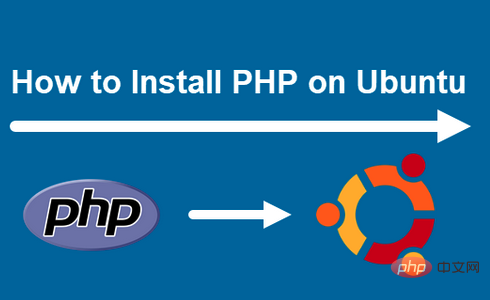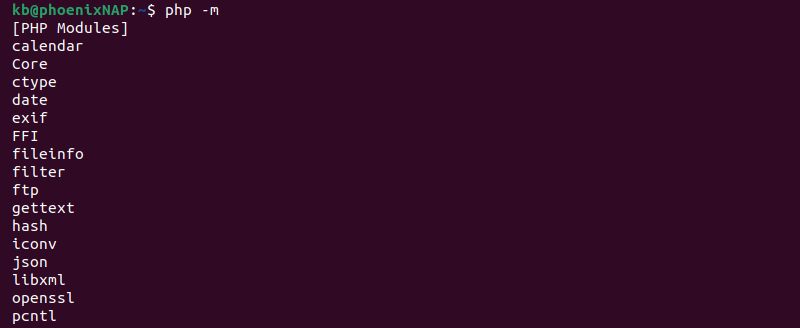Introduction
PHP stands for Hypertext Preprocessor, and it's a script-based server-side programming language.
PHP helps automate various server tasks. It handles tasks such as dynamic content, database requests, and data preprocessing/display.
Read our tutorial on how to install PHP on Ubuntu 20.04 or 22.04 including integration with Apache and Nginx.

Installing PHP on Ubuntu
Like many developer tools, PHP has several different release versions. At the time of writing, PHP 7.4. and 8.1 are the currently supported and most used versions of the software.
The following command installs PHP using the apt package manager:
sudo?apt?install?php
On Ubuntu 20.04, the command installs PHP 7.4 while Ubuntu 22.04 installs PHP version 8.1.
If you're looking to choose the specific version of PHP on either system, follow one of the installation steps below.
1. Install PHP with Apache on Ubuntu
If you are running an Apache web server, install PHP with the Apache module. Below you will find installations for both PHP 7.4 and PHP 8.1.
1. Ensure you are using the latest repository updates by entering the following command into a terminal window:
sudo?apt?update?&&?sudo?apt?upgrade
2. Install software-properties-common to help you manage distributions and independent software sources:
sudo?apt?install?software-properties-common
If the package is already available, continue to the next step.
3. Next, add the ondrej/php PPA which provides different PHP versions for Ubuntu:
sudo?add-apt-repository?ppa:ondrej/php
After the PPA loads, press Enter to confirm adding the repository. The available PHP versions in the PPA are from 5.6 up to 8.2.
4. Update apt to include the new packages:
sudo?apt?update
5. Now you can install specific PHP versions. For example:
- To install PHP 7.4, run the command:
sudo?apt?-y?install?php7.4
- To install PHP 8.1, run the following command:
sudo?apt?-y?install?php8.1
6. Verify the installation with:
php?-v
The output displays the PHP version you installed.
If you installed version 7.4, the output appears as in the image below.

If you installed PHP 8.1, the output shows:

2. Install PHP with Nginx on Ubuntu
The Nginx server does not have native PHP processing. If you are using an Nginx server instead of Apache, follow the steps below to install PHP 7.4 or 8.1 to work with Nginx.
1. Enter the following command into a terminal window to ensure you are using the latest software:
sudo?apt?install?php
2. Add the ondrej/php PPA to include various PHP versions:
sudo?apt?update?&&?sudo?apt?upgrade
When the PPA information loads, press Enter to continue.
2. To install PHP for Nginx, use one of the following commands:
- For PHP 7.4:
sudo?apt?install?software-properties-common
- For PHP 8.1:
sudo?add-apt-repository?ppa:ondrej/php
The system will reach out to download and install the package and its dependencies.

2. Once the installation finishes, restart the Nginx service to apply the changes by entering:
sudo?apt?update
3. Next, enable PHP support by editing the server block. Open the server block with the command:
sudo?apt?-y?install?php7.4
4. Add the following code to your server block file for Nginx to make use of PHP:
sudo?apt?-y?install?php8.1
Exchange the
4. Save the file and exit.
5. Finally, restart Nginx on Ubuntu and reload PHP:
php?-v
sudo?apt?update?&&?sudo?apt?upgrade
Installing PHP Modules on Ubuntu
To install additional PHP modules, use the following syntax:
sudo?add-apt-repository?ppa:ondrej/php
For example:
sudo?apt?install?php7.4-fpm?-y
Alternatively, install multiple modules at once. For example, to install modules mysql, zip and bcmath on PHP 7.4, you would run:
sudo?apt?install?php8.1-fpm?-y
To list all loaded PHP modules run the command:
sudo?systemctl?restart?nginx
The output lists all compiled PHP modules, as in the example below.

How to Uninstall PHP on Ubuntu
To uninstall PHP from Ubuntu, follow the instructions below:
1. Run the following command in the terminal:
sudo?nano?/etc/nginx/sites-available/default
For example, if you installed the PHP 7.4 FPM version, run:
server{
??#?.?.?.?existing?configuration
??location?~?.php$?{
????include?snippets/fastcgi-php.conf;
????fastcgi_pass?unix:/run/php/php<version>-fpm.sock;
??}
}</version>
2. Remove the orphaned packages with:
sudo?systemctl?restart?nginx
3. Lastly, check the PHP version to confirm the uninstall worked:
sudo?systemctl?reload?php<version_number>-fpm</version_number>
If the output does not show the version, the uninstall removed everything correctly.
The above is the detailed content of How To Install PHP On Ubuntu. For more information, please follow other related articles on the PHP Chinese website!

Hot AI Tools

Undress AI Tool
Undress images for free

Undresser.AI Undress
AI-powered app for creating realistic nude photos

AI Clothes Remover
Online AI tool for removing clothes from photos.

Clothoff.io
AI clothes remover

Video Face Swap
Swap faces in any video effortlessly with our completely free AI face swap tool!

Hot Article

Hot Tools

Notepad++7.3.1
Easy-to-use and free code editor

SublimeText3 Chinese version
Chinese version, very easy to use

Zend Studio 13.0.1
Powerful PHP integrated development environment

Dreamweaver CS6
Visual web development tools

SublimeText3 Mac version
God-level code editing software (SublimeText3)

Hot Topics
 1794
1794
 16
16
 1739
1739
 56
56
 1590
1590
 29
29
 1467
1467
 72
72
 267
267
 587
587
 Commenting Out Code in PHP
Jul 18, 2025 am 04:57 AM
Commenting Out Code in PHP
Jul 18, 2025 am 04:57 AM
There are three common methods for PHP comment code: 1. Use // or # to block one line of code, and it is recommended to use //; 2. Use /.../ to wrap code blocks with multiple lines, which cannot be nested but can be crossed; 3. Combination skills comments such as using /if(){}/ to control logic blocks, or to improve efficiency with editor shortcut keys, you should pay attention to closing symbols and avoid nesting when using them.
 PHP Comparison Operators
Jul 18, 2025 am 04:57 AM
PHP Comparison Operators
Jul 18, 2025 am 04:57 AM
PHP comparison operators need to pay attention to type conversion issues. 1. Use == to compare values only, and type conversion will be performed, such as 1=="1" is true; 2. Use === to require the same value as the type, such as 1==="1" is false; 3. Size comparison can be used on values and strings, such as "apple"
 PHP Constants: Const vs. Define
Jul 18, 2025 am 04:56 AM
PHP Constants: Const vs. Define
Jul 18, 2025 am 04:56 AM
Defining constants in PHP, const is more suitable for constant definitions inside classes, and define() is more flexible and suitable for global or dynamic definitions. 1.const is a language structure, and must be a compile-time constant expression when defined, which is suitable for class or global namespaces; define() is a function, and the value can be the result of runtime calculation. 2.const is affected by the namespace, and the constants defined by define() are visible globally by default. 3. The const structure is clear and the IDE is good, which is suitable for object-oriented design; define() has high flexibility but may have higher maintenance costs. 4. define() supports runtime condition judgment and dynamic definition, but const does not support it. Therefore, class-related constants preferentially use co
 Go for Audio/Video Processing
Jul 20, 2025 am 04:14 AM
Go for Audio/Video Processing
Jul 20, 2025 am 04:14 AM
The core of audio and video processing lies in understanding the basic process and optimization methods. 1. The basic process includes acquisition, encoding, transmission, decoding and playback, and each link has technical difficulties; 2. Common problems such as audio and video aberration, lag delay, sound noise, blurred picture, etc. can be solved through synchronous adjustment, coding optimization, noise reduction module, parameter adjustment, etc.; 3. It is recommended to use FFmpeg, OpenCV, WebRTC, GStreamer and other tools to achieve functions; 4. In terms of performance management, we should pay attention to hardware acceleration, reasonable setting of resolution frame rates, control concurrency and memory leakage problems. Mastering these key points will help improve development efficiency and user experience.
 Using the Translator facade for Localization in Laravel.
Jul 21, 2025 am 01:06 AM
Using the Translator facade for Localization in Laravel.
Jul 21, 2025 am 01:06 AM
TheTranslatorfacadeinLaravelisusedforlocalizationbyfetchingtranslatedstringsandswitchinglanguagesatruntime.Touseit,storetranslationstringsinlanguagefilesunderthelangdirectory(e.g.,en,es,fr),thenretrievethemviaLang::get()orthe__()helperfunction,suchas
 How to use PHP to develop a Q&A community platform Detailed explanation of PHP interactive community monetization model
Jul 23, 2025 pm 07:21 PM
How to use PHP to develop a Q&A community platform Detailed explanation of PHP interactive community monetization model
Jul 23, 2025 pm 07:21 PM
1. The first choice for the Laravel MySQL Vue/React combination in the PHP development question and answer community is the first choice for Laravel MySQL Vue/React combination, due to its maturity in the ecosystem and high development efficiency; 2. High performance requires dependence on cache (Redis), database optimization, CDN and asynchronous queues; 3. Security must be done with input filtering, CSRF protection, HTTPS, password encryption and permission control; 4. Money optional advertising, member subscription, rewards, commissions, knowledge payment and other models, the core is to match community tone and user needs.
 Go for Scientific Computing and Numerical Analysis
Jul 23, 2025 am 01:53 AM
Go for Scientific Computing and Numerical Analysis
Jul 23, 2025 am 01:53 AM
Go language can be used for scientific calculations and numerical analysis, but it needs to be understood. The advantage lies in concurrency support and performance, which is suitable for parallel algorithms such as distributed solution, Monte Carlo simulation, etc.; community libraries such as gonum and mat64 provide basic numerical calculation functions; hybrid programming can be used to call C/C and Python through Cgo or interface to improve practicality. The limitation is that the ecosystem is not as mature as Python, the visualization and advanced tools are weaker, and some library documents are incomplete. It is recommended to select appropriate scenarios based on Go features and refer to source code examples to use them in depth.
 How to use PHP to develop product recommendation module PHP recommendation algorithm and user behavior analysis
Jul 23, 2025 pm 07:00 PM
How to use PHP to develop product recommendation module PHP recommendation algorithm and user behavior analysis
Jul 23, 2025 pm 07:00 PM
To collect user behavior data, you need to record browsing, search, purchase and other information into the database through PHP, and clean and analyze it to explore interest preferences; 2. The selection of recommendation algorithms should be determined based on data characteristics: based on content, collaborative filtering, rules or mixed recommendations; 3. Collaborative filtering can be implemented in PHP to calculate user cosine similarity, select K nearest neighbors, weighted prediction scores and recommend high-scoring products; 4. Performance evaluation uses accuracy, recall, F1 value and CTR, conversion rate and verify the effect through A/B tests; 5. Cold start problems can be alleviated through product attributes, user registration information, popular recommendations and expert evaluations; 6. Performance optimization methods include cached recommendation results, asynchronous processing, distributed computing and SQL query optimization, thereby improving recommendation efficiency and user experience.




